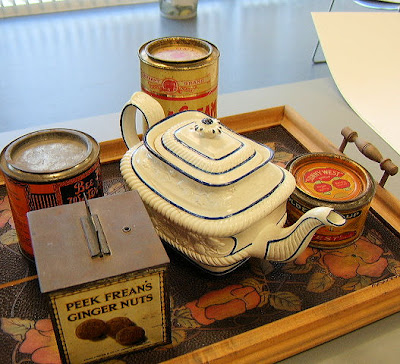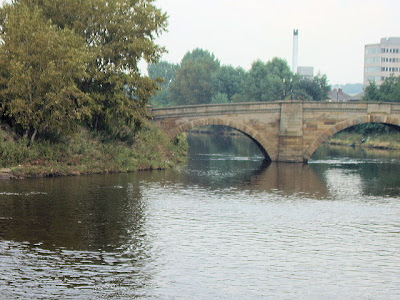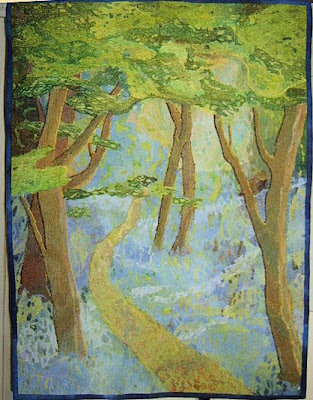
A tenuous link to the topic for the day, but it makes for a nice photo.
Topic for the day, in case you haven't guessed, is time. How we use it, waste it, get resentful of it and what to do about it. Inspired by several posts recently on my good friend Marie's blog
http://zquilts.blogspot.com/ .
For many of us, the problem is not having enough of it. For many years I was a full-time teacher which, with preparation, marking, training out of school hours and so on meant an average of between 50 and 65 hours a week in term-time; to this I somehow added being a local NUT (teachers' union) officer plus local labour party officer and school governor. On Monday nights I had two hours I carved out for myself which I prioritised as me time when I went to a patchwork and quilting class.
The inevitable happened - with a little help from the education authority (schools in Leeds were reorganised) and the government (the whole education system in England and Wales underwent radical changes - to my mind not for the better) and the fact that the school I worked in was part building site. I achieved burnout. To be more specific, I ended up, after a period of trying to work through illness, with Chronic Fatigue Syndrome (CFS - what used to be called ME) and had to retire from teaching (and everything else) and was unable to work at all for five years.
However, having CFS (which you never completely get rid of - I still suffer the symptoms at times, though in a very minor way) taught me a lot about managing time and keeping up morale.
There are no quick fixes for this condition - you have to learn to live with it; if you manage it carefully you improve, but there are no guarantees: I was one of the lucky ones. Some things I had to give up - reading for the first two years (I could not maintain concentration for long enough); machine stitching (couldn't sit at the machine for long); couldn't even watch television for long (ended up seeing double when I exhausted the eye muscles so the two sets couldn't work in synch properly).
What I learnt to do was this: to do things but in short stints (sometimes as little as ten minutes) with rests in between. I learnt to see rest as a positive thing and not feel guilty about appearing to be lazy. I learnt that I was more likely to get the bouts of depression associated with CFS if the things I did manage to do included not only things I ought to do but also things I wanted to do. I learnt to compromise. As I improved I learnt that it was possible to do some of the big things I wanted to by resting beforehand, taking it as easily as I could at the time, and being prepared to suffer afterwards (after my first quilt show at this time I was ill for a week and could only get upstairs on all fours). I also learnt to adapt: you can iron sitting down; it's an interesting exercise choosing domestic appliances using weight as your foremost criterion - I managed to buy the worst vacuum cleaner in the world that way!
One of the things I found most useful is an exercise I was taught in a time management class, basically as a prioritisation exercise for busy managers.
(i) You begin by defining your discretionary time - that is the time that isn't timetabled or given to routine things that have to be done every day - i.e. time where you get some choice about what you do.
(ii) Then each day you begin by making two lists, one of ten things you want to do and one of ten things you ought to do. It's not unusual for some things to appear in both lists. Having to find ten things you want to do makes you dig deeper into the possibilities of just how you could use your time if you weren't forever trying to catch up on the "oughts". One suggestion - make the items relatively small - preferably no more than an hour (it can be considerably less!), two at the outside - break down larger things into smaller stages.
(iii) Next stage is to prioritise. Look at your lists and pick out the one thing you most want to do; one thing you ought to do which is most urgent. Start a new list and write these down as items 1 and 2, then bracket them together.
(iv) Leave a space on your list then write down the numbers 3 to 6, one on each line. Choose the next two things you'd most like to do and the two things you most ought to do and write these in: again bracket them together.
(v) Repeat the process for items 7 to 10.
Do not agonise over this process - it should normally take less than ten minutes.
What you now have is a working list for the day. You work your way down the list. The only thing you HAVE to do is complete the first two priority items. If you manage to get to six you are doing well. Few people manage all ten. Any things you haven't done can go onto next day's list - or you may find they're not as important as you thought and they can disappear altogether.
I found this useful when I had little time at my disposal. I find it even more useful now I am retired and have oodles of time. It means I can give my days a structure. It means I am finally getting to grip with actually doing the "oughts" instead of fretting about them, and establishing a reasonable routine for getting them done. I'm also becoming clearer about the things I really want to do and achieving more than I would have expected. And I feel pleased with myself and positively enjoy life. There is no danger of what I feared most about retirement - that I would become a hermit and sink deeper and deeper into my armchair!
The most valuable thing about this system is that it puts things you want and things you ought to do on a par, as having equal value, something that we as women often don't allow ourselves to do. It also means that you can keep your morale high by not spending all your time doing things you ought to do (you do however get through the things you really ought to do though maybe a little more slowly).
But most importantly it makes you redefine your wants and needs. Once things have been on the first list for several days but not made it as priorities you begin to reappraise whether the oughts are really things you need to do after all, or whether the things on your want list are as important to you as you thought. It teaches you that whilst you cannot have it all you can have the things that are really important and that feels good.
And finally a story about letting go of those oughts:
A friend of mine, when we were both teaching, spent the last afternoon of the summer term filling a huge bag with things she had to get done during the summer vacation or the earth would stop spinning on its axis. She left the bag in her office to be collected after the end of term party.
After the end of term party she forgot about it (wine can do this to you). One of the cleaners next morning tidied the bag away into a cupboard. The following summer term my friend cleared out the cupboard and found the bag. She had not missed any of the things in it. None of the things had been done, and nobody missed them, least of all her.







 This month's challenge had also to be composed of basically complementary colours, and had to have a strong vertical, horisontal or diagonal composition.
This month's challenge had also to be composed of basically complementary colours, and had to have a strong vertical, horisontal or diagonal composition. I simplified the photograph, flattening the perspective, and exaggerating the height. The water-shapes have been simplified considerably too, to give a poster-like effect. In fact the design is what took longest (I have to work hard to get to be this simple!). Fabric pieces have been fused onto a dark blue background which has been allowed to show through in places because I wanted it not to look too smooth.
I simplified the photograph, flattening the perspective, and exaggerating the height. The water-shapes have been simplified considerably too, to give a poster-like effect. In fact the design is what took longest (I have to work hard to get to be this simple!). Fabric pieces have been fused onto a dark blue background which has been allowed to show through in places because I wanted it not to look too smooth.



















 This was made during Myrna Giesbrecht's Self Expressions class at Quilt University, a life-changing class if ever there was one and highly recommended. We were asked to produce a small quilt which expressed where we were at the time. I decided to focus on the whole process of creativity and came up with the idea of a game of snakes and ladders to describe it in a light-hearted way. The grid was the board and I'd originally decided to applique the snakes and the ladders.
This was made during Myrna Giesbrecht's Self Expressions class at Quilt University, a life-changing class if ever there was one and highly recommended. We were asked to produce a small quilt which expressed where we were at the time. I decided to focus on the whole process of creativity and came up with the idea of a game of snakes and ladders to describe it in a light-hearted way. The grid was the board and I'd originally decided to applique the snakes and the ladders.
 Though I really don't like real snakes much at all to the point of being phobic I am also quite fascinated by them, especially the symbolism of snakes, and during the course of this they became a sort of symbol for creativity.
Though I really don't like real snakes much at all to the point of being phobic I am also quite fascinated by them, especially the symbolism of snakes, and during the course of this they became a sort of symbol for creativity. This is where it was just over a week ago. The satin stitch has now been strengthened to make the ladders clearer and it has been extensively machine-quilted. As a result of the stitching it is now slightly lumpy and I intend to block it before adding the binding (I had originally planned to face it but it needs a fine strip of colour round the outside - now for the agonising decision as to what colour to use - any advice greatly appreciated!)
This is where it was just over a week ago. The satin stitch has now been strengthened to make the ladders clearer and it has been extensively machine-quilted. As a result of the stitching it is now slightly lumpy and I intend to block it before adding the binding (I had originally planned to face it but it needs a fine strip of colour round the outside - now for the agonising decision as to what colour to use - any advice greatly appreciated!)













 Can't make up my mind about the Monday and Tuesday ones - broadly I think I haven't got there yet but there are things worth exploring, especially the way it's possible to layer scrim and stitch to get a painterly effect.
Can't make up my mind about the Monday and Tuesday ones - broadly I think I haven't got there yet but there are things worth exploring, especially the way it's possible to layer scrim and stitch to get a painterly effect.



